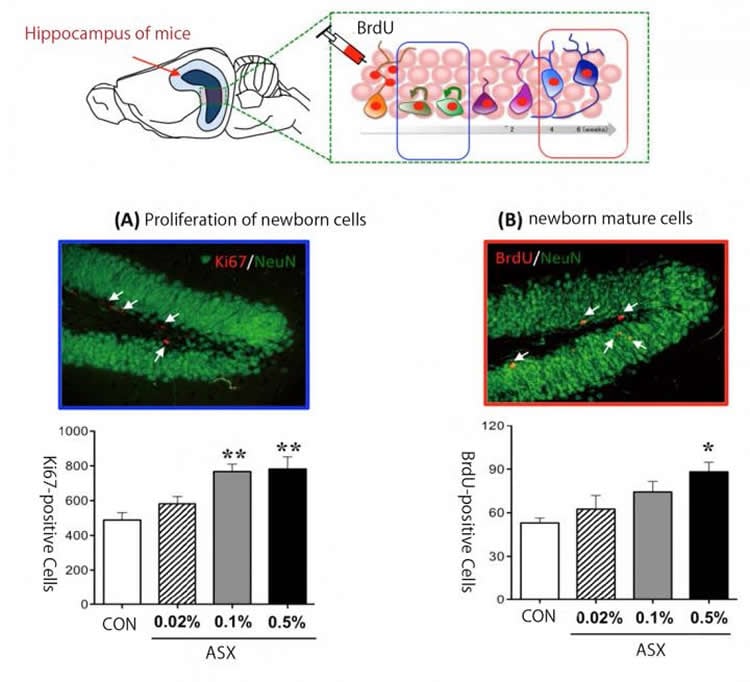New light shed on neurogenesis in the hippocampus and the molecular basis for the promotion of spatial memory capacity.
A research group led by University of Tsukuba Professor Hideaki Soya and Professor Randeep Rakwal has investigated the effect on hippocampal function of the naturally derived pigment ASX, which is believed to have the most powerful antioxidant activity among carotenoids. Their results showed for the first time that giving ASX to mice for four weeks promoted neurogenesis in the hippocampus in a concentration-dependent manner, and elevated the learning and memory capacity of the hippocampus.
With the recent rise in popularity of naturally-derived supplements to maintain a healthy body, there has been a great deal of attention toward development of the so-called “brain foods”, which can enhance brain function. Of particular importance is the natural red pigment astaxanthin (ASX) abundant in both salmon and in crustaceans such as shrimp and crab. ASX has a powerful antioxidant effect, and it holds promise as a next-generation natural supplement. ASX is capable of penetrating the blood-brain barrier,entering the brain, where it acts directly on nerve cells. ASX is also known to have a neuroprotective effect in neurological animal disease model. However, there are many unanswered questions as to the effects of ASX on hippocampal function, especially whether or not it can increase the neuroplasticity of the hippocampus.

A research group led by University of Tsukuba Faculty of Health and Sport Sciences Professor Hideaki Soya and Professor Randeep Rakwal has investigated the effect on hippocampal function of the naturally-derived pigment ASX, which is believed to have the most powerful antioxidant activity among carotenoids. Their results showed for the first time that giving ASX to mice for four weeks promoted neurogenesis in the hippocampus in a concentration-dependent manner, and elevated the learning and memory capacity of the hippocampus. Furthermore, when the team investigated the molecular mechanism of the ASX activity on the hippocampus using high-throughput DNA microarray technology and bioinformatics analyses such as IPA, it brought to the fore specific molecular pathways that could contribute to improved memory capacity.
By conducting future targeting experiments on the molecular mechanism behind ASX action, as hypothesized from these bioinformatics analyses, aimed at hippocampal tissues and cells with gene deletion methods or specific inhibitors, researchers may be able to clarify the mechanism in greater detail, which could help target mechanisms in the development of medical foods and new drugs.
Funding: Funding was provided by Ministry of Education, Culture, Sports, Science and Technology, Japan Society for the Promotion of Science.
Source: Masataka Watanabe – University of Tsukuba
Image Credit: The image is credited to University of Tsukuba.
Original Research: Abstract for “Astaxanthin supplementation enhances adult hippocampal neurogenesis and spatial memory in mice” by Jang Soo Yook, Masahiro Okamoto, Randeep Rakwal, Junko Shibato, Min Chul Lee, Takashi Matsui, Hyukki Chang, Joon Yong Cho and Hideaki Soya in Molecular Nutrition and Food Research. Published online January 7 2016 doi:10.1002/mnfr.201500634
Abstract
Astaxanthin supplementation enhances adult hippocampal neurogenesis and spatial memory in mice
Scope
There is a growing necessity for efficacious natural supplements with antioxidant effects on the brain, in particular, hippocampal function. One such compound, which also has a neuroprotective effect, is the carotenoid astaxanthin (ASX). Despite ASX’s potential benefit to the brain, very little is known about its effect on hippocampal plasticity and cognition. Thus, we investigated the effect of ASX on adult hippocampal neurogenesis (AHN) and spatial memory using a mouse model.
Methods and results
Dose-response was examined in mice fed ASX-supplemented diets (0, 0.02, 0.1, and 0.5%) to define the effect of ASX on AHN. In conjunction with AHN results, hippocampus-dependent cognitive function was assessed. We delineated molecular mechanisms associated with ASX-enhanced AHN using DNA microarray analysis. Results revealed that ASX enhanced cell proliferation and survival at 0.1% and 0.5% doses. Newborn mature neurons were higher only with 0.5% ASX, which also enhanced spatial memory. Transcriptomic profiling revealed potential AHN-associated molecules (Prl, Itga4, and Il4) that were ASX induced. Their downstream factors, identified through Ingenuity Pathway Analysis, were positively correlated with ASX-induced increases in spatial memory.
Conclusion
ASX supplementation enhanced AHN and spatial memory, and a DNA microarray approach provided, for the first time, novel molecular insights into ASX action.
“Astaxanthin supplementation enhances adult hippocampal neurogenesis and spatial memory in mice” by Jang Soo Yook, Masahiro Okamoto, Randeep Rakwal, Junko Shibato, Min Chul Lee, Takashi Matsui, Hyukki Chang, Joon Yong Cho and Hideaki Soya in Molecular Nutrition and Food Research. Published online January 7 2016 doi:10.1002/mnfr.201500634






